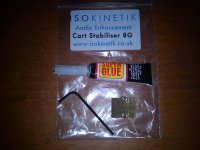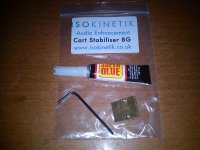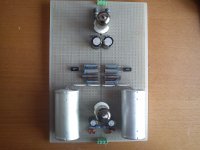Let me know the exact readings of R4, C2, C3, R3 and R5
R4 6K75
C2 47nF
C3 15.333nF
R3 6K75
R5 1M
R3 ?
Can you please post the type of resistors and caps used ?
I will do the simulation after dinner 🙂
Can you please post the type of resistors and caps used ?
I will do the simulation after dinner 🙂
R3 47K Vishay nude Tx2575
R4 6K8 Vishay nude Tx2575 + 1Meg Caddock TF020
R5 1Meg Caddock MK132
C2 47nF teflon film & aluminium foil + SM
C3 15.333nF teflon film & aluminium foil + SM
thanks for simulation & help
R4 6K8 Vishay nude Tx2575 + 1Meg Caddock TF020
R5 1Meg Caddock MK132
C2 47nF teflon film & aluminium foil + SM
C3 15.333nF teflon film & aluminium foil + SM
thanks for simulation & help
You wrote you have 47k parallel with 1M
Do you also have 6k8 parallel with 1M ?
Sorry I forgot I also need R1.... is it true 3k3 ?
Do you also have 6k8 parallel with 1M ?
Sorry I forgot I also need R1.... is it true 3k3 ?
Last edited:
If R1 = 3k3
I would try the following:
R3 = 47k // 1M (Perfect value would be 1M1)
R4 = 6k8 // 1M
C2 = 47nF // 100pF
C3 = 15.33nF
I would try the following:
R3 = 47k // 1M (Perfect value would be 1M1)
R4 = 6k8 // 1M
C2 = 47nF // 100pF
C3 = 15.33nF
Sorry Ricardo I did a mistake the only paralleled 1Meg resistor is with 6K8, yes R1 is a Kiwame 3K3 rated 5% but real 0.5%
Last edited:
If R1 = 3k3
I would try the following:
R3 = 47k // 1M (Perfect value would be 1M1)
R4 = 6k8 // 1M
C2 = 47nF // 100pF
C3 = 15.33nF
I don't have 1M1 but have 1M, also I have 100pF, I will do tomorrow & let you know, thanks again Ricardo.
You do not need to solder the 1M or the 100p.... Just clip them in place using mini alligators.
Please note that the result highly depends on the gain but this way you will have much more presence in the power band and the highs will seem more integrated.
If you feel it lacks highs, you can lower C3 to 15.1nF as per Salas pdf.
Thank you so much for your work. I am looking forward for your opinion 🙂
Please note that the result highly depends on the gain but this way you will have much more presence in the power band and the highs will seem more integrated.
If you feel it lacks highs, you can lower C3 to 15.1nF as per Salas pdf.
Thank you so much for your work. I am looking forward for your opinion 🙂
Ricardo, the values can be measured with components soldered or you want that I measure each component desoldered.
Caps are real value unsoldered
Resistors are real value unsoldered
N.B. I did I mistake about these resistance values, the right values unsoldered:
R3 45K804 0.01%
R4 6k81 0.01%
Sorry for extra work & many thanks again.
You have P.M.
Caps are real value unsoldered
Resistors are real value unsoldered
N.B. I did I mistake about these resistance values, the right values unsoldered:
R3 45K804 0.01%
R4 6k81 0.01%
Sorry for extra work & many thanks again.
You have P.M.
If R3 = 45k804 and R4 = 6k81
I would use
R3 = 45804 // 3M
C2 = 47nF // 10pF (Silver micas are ok here)
I would use
R3 = 45804 // 3M
C2 = 47nF // 10pF (Silver micas are ok here)
If R3 = 45k804 and R4 = 6k81
I would use
R3 = 45804 // 3M
C2 = 47nF // 10pF (Silver micas are ok here)
Ricardo sorry for the trouble:
R3 45K804
R4 6K81 is paralleld with 1Meg = 6K764
Last edited:
I already am taking that in consideration.
Just add a 3M in parallel with the 45k804.
That will keep you very close to the 500.5 pole and will give you more presence in the mids.
The C2 = 47nF with 10pF in parallel can be done latter.
Just add a 3M in parallel with the 45k804.
That will keep you very close to the 500.5 pole and will give you more presence in the mids.
The C2 = 47nF with 10pF in parallel can be done latter.
So I left C2 47nF & only parallel 3M with 45K804, right?
Now I have 1M paralleled with 45K804 & 47nF paralleled with 100pF & sounds great
Now I have 1M paralleled with 45K804 & 47nF paralleled with 100pF & sounds great
1M would be good if you had 47k but as you have a lower value, 45k804 you need to parallel 3M.
In this case 100p for the 47n is too much.... 10p should do it but you can try without it because the DMM error might be more influential than this small cap.
In this case 100p for the 47n is too much.... 10p should do it but you can try without it because the DMM error might be more influential than this small cap.
Last edited:
First listening tests shows that now the RIAA is very accurate because sounds very equilibrated to mi ears just by curiousity I'm tempted to buy the inverse RIAA to Jim Hagerman to be sure if measure well.
I don't have words to express my grateful for your excellent job Ricardo, could you help me with another tube RIAA for a friend?
I don't have words to express my grateful for your excellent job Ricardo, could you help me with another tube RIAA for a friend?
Let it burn for a while and than report back so we can see if you keep your first impressions 🙂
My simulations never go far away from the proposed Salas values... I just try to find the needed adjustments to fine tune the 500.5 Hz turnover point based on DMM measurements of all the real parts. This 318uS pole is really important for the real instrument´s timbre reproduction.
As for the tube riaa I can try ... Let me know the schematic and the DMM values of the unsoldered parts.
This will be very usefull as a starting point because I want to try the itch 🙂
PS:
Hagerman´s Iriaa includes a 3.18uS 50kHz pole ... It will not work perfectly in this case.
My simulations never go far away from the proposed Salas values... I just try to find the needed adjustments to fine tune the 500.5 Hz turnover point based on DMM measurements of all the real parts. This 318uS pole is really important for the real instrument´s timbre reproduction.
As for the tube riaa I can try ... Let me know the schematic and the DMM values of the unsoldered parts.
This will be very usefull as a starting point because I want to try the itch 🙂
PS:
Hagerman´s Iriaa includes a 3.18uS 50kHz pole ... It will not work perfectly in this case.
Last edited:
Only curiosity: why Hagerman IRIAA don't work in this case?
Received today other toy to play: Isokinetik to add 8gr effective mass to tonearm😉
Because hagerman does not follow Lipshitz riaa curve in the higher frequencies. Haggerman (as well as AMS and Dartzel) prefer a boost in the high frequencies with an extra pole at 50kHz.
Always wondered about the Isokinetik stuff... let us know how it sounds.
- Home
- Source & Line
- Analogue Source
- Simplistic NJFET RIAA



